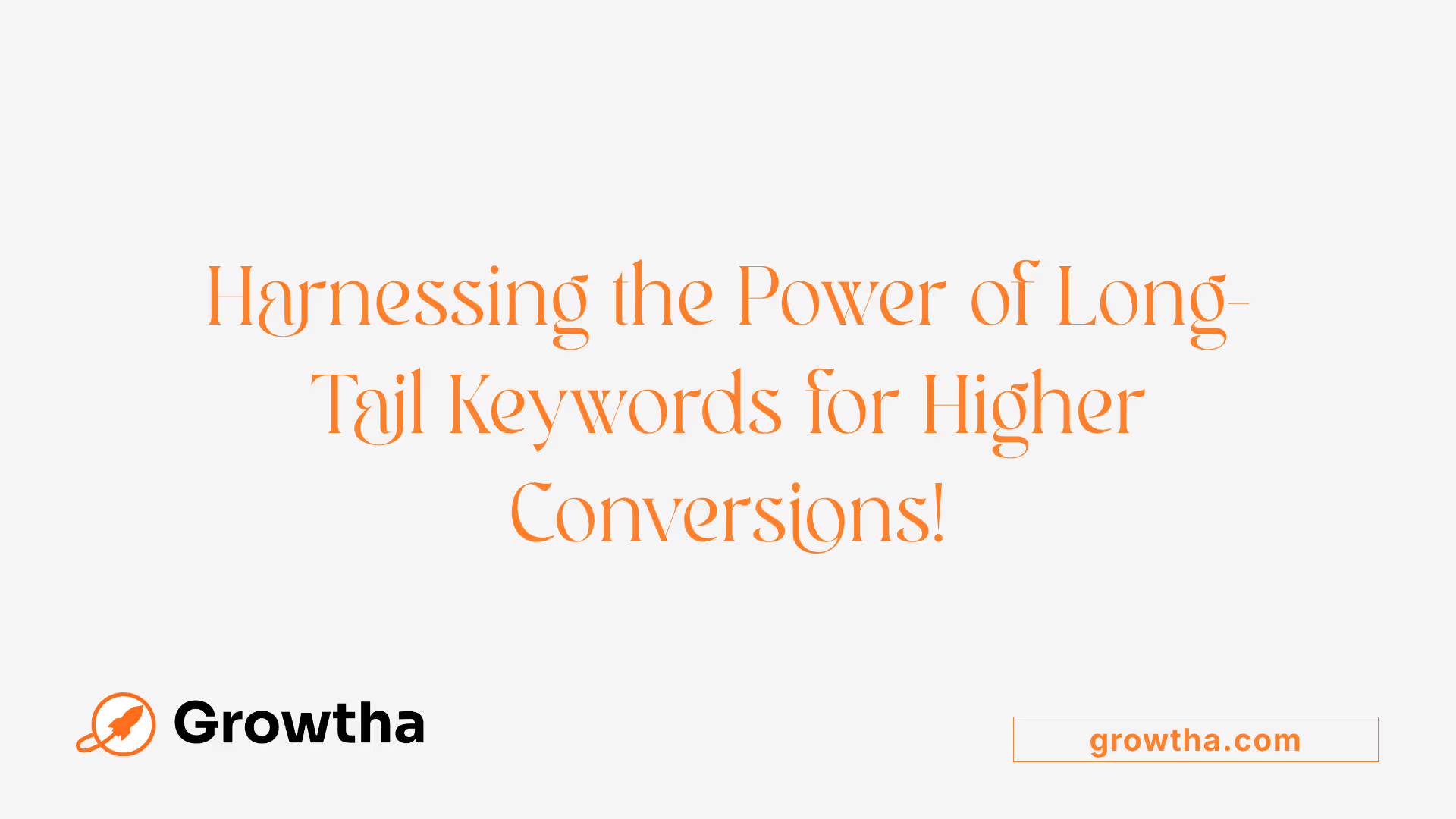How Many SEO Keywords Should I Use?
The main types of keywords in SEO significantly influence the strategy behind content creation and optimization. They are categorized into four distinct groups.


How Many SEO Keywords Should I Use?
Unlocking the Power of SEO Keywords
Understanding SEO Keywords
In the ever-evolving world of digital marketing, SEO keywords stand as a cornerstone of any successful online strategy. These are the terms and phrases that align with user search queries, facilitating higher search engine rankings and improved visibility. Understanding and leveraging SEO keywords effectively can make the difference between a hidden website and a bustling digital hub.
Decoding SEO Keywords

What are SEO keywords and how are they identified?
SEO keywords, also known simply as keywords or key phrases, are terms incorporated into online content to enhance search engine rankings and visibility. They serve as a bridge, connecting users with the content they seek. Identifying the right keywords involves a thorough process of keyword research, which evaluates several factors such as search volume, competition, and commercial intent. Utilizing tools like Google Keyword Planner, Semrush, and Google Trends can significantly aid in discovering relevant keywords and tracking trends over time. A strategic focus on long-tail keywords—phrases containing four or more words—can be particularly advantageous, as they often present lower competition and shun the struggle faced by newcomers in the SEO sphere. The selection of effective keywords is a cornerstone of successful SEO strategies, influencing a site's visibility and its potential to attract targeted traffic.
Understanding the Importance of Keyword Research
The importance of keyword research cannot be overstated as it lays the foundation for any SEO initiative. Exclusive reliance on common or overly generic keywords can lead to fierce competition, making it difficult for websites to gain traction. Therefore, incorporating a blend of broad and specific, or niche, keywords is essential. Moreover, neglecting to perform ongoing keyword evaluation can result in a stagnant keyword strategy; regularly revisiting older keywords and replacing them with emerging competitive alternatives strengthens a site's positioning in search results. This adaptive approach, alongside a diversified keyword usage, ensures that a site stands out, effectively connecting with users who might otherwise overlook it amid a sea of competition.
Key Elements of Effective Keyword Strategy
Element Description Example Search Intent Understanding what users are looking to discover or purchase. Differentiating between informational searches and purchasing intent. Keyword Placement Strategic integration of keywords throughout the site. Incorporating keywords into titles, headings, and URLs. Long-Tail Focus Emphasizing longer phrases to reduce competition. Using specific descriptors such as 'best eco-friendly cleaning products'.
Types and Roles of Keywords in SEO

What are the main types of keywords in SEO and their importance?
The main types of keywords in SEO significantly influence the strategy behind content creation and optimization. They are categorized into four distinct groups:
Keyword Type Description Importance Informational Keywords These are phrases aimed at users seeking information. Vital for educational content, engaging users who want to learn. Transactional Keywords Indicate intent to make a purchase or perform a transaction. Essential for driving conversions, capturing ready-to-buy users. Commercial Keywords Reflect a research phase where users evaluate options. Important for targeting consumers who are considering purchases. Navigational Keywords Used when users search for specific sites or pages. Crucial for maintaining brand visibility, ensuring users find you.
These keyword types not only help optimize content for particular user intents but also shape how websites connect with different stages in the customer journey, thereby maximizing online presence.
Choosing the Right Keywords for Your Website

How do I choose effective SEO keywords for my website?
To choose effective SEO keywords for your website, start by conducting thorough keyword research using tools like Google Keyword Planner and HubSpot's Content Strategy tool. This process should begin with creating topic lists and analyzing user intent to ensure the selected keywords align with your audience's needs. Focus on identifying moderate competition opportunities that also present a decent search volume. It's essential to maintain a balance between head terms, which are typically short and competitive, and long-tail keywords, generally longer phrases that tend to be less contested. Additionally, utilizing Google Search Console insights can help reveal the specific queries driving traffic to your site. Engaging with your sales and support teams will provide direct customer feedback, further enriching your strategy. Finally, evaluate your Domain Authority (DA) to assess which keywords you might realistically rank for.
Steps in selecting effective keywords
Step Action Tools/Resources 1. Conduct Research Gather keywords based on search volume and intent Google Keyword Planner, Ahrefs 2. Analyze Competition Identify keywords with manageable competition Google Search Console 3. Prioritize Keywords Select a mix of head and long-tail keywords Keyword Tool, WordStream 4. Validate with Audience Insight Consult teams for customer feedback Internal surveys 5. Monitor Performance Evaluate keyword ranking and traffic sources Website analytics tools
Tools to assist in keyword selection
Various tools can facilitate your keyword selection process. Google Trends is effective for gauging the popularity of keywords over time, allowing you to target timely topics. The Free Keyword Tool by WordStream provides insights into keyword search volume, CPC (cost per click), and competition data. Additionally, Keyword Tool enables users to generate keyword suggestions based on Google Autocomplete data, enhancing the relevance of suggested keywords. For more specific needs, tools like Semrush can analyze search trends and related key phrases, effectively integrating into your overall SEO strategy.
Effective Use of Keyword Research Tools
How can I leverage different keyword research tools effectively?
To leverage different keyword research tools effectively, start by defining your specific needs, such as identifying new keywords or analyzing competition. Utilize tools like Google Keyword Planner, SEMrush, and WordStream, which offer features such as search volume data and competition analysis. Keeping your keyword list dynamic is crucial; consistently revisit it to include both high-volume competitive keywords and long-tail keywords, adapting to shifting market dynamics. Implementing keyword grouping can help organize your keywords into actionable segments, thus enhancing the effectiveness and efficiency of your SEO strategy. Moreover, consider features like contextual suggestions and the Opportunity Score in tools like WordStream to prioritize keywords and maximize your marketing efforts. This strategic approach facilitates a comprehensive understanding of keyword performance and allows for informed decision-making in content creation strategy.
Exploring the Google Keyword Planner
Features of Google Keyword Planner
The Google Keyword Planner is a vital tool for anyone involved in search engine optimization (SEO), offering insights into the landscape of online search. It aids users in identifying popular keywords and their monthly search volumes, allowing businesses to tailor their content effectively. This tool provides data direct from Google, therefore ensuring the relevance and reliability of keywords. Users can also filter keyword suggestions by industry, allowing for more relevant and customized keyword lists that align with specific business goals. Moreover, it tracks search volume over time using Google Trends, helping marketers stay ahead of the curve and target topics with increasing interest.
Limitations and Advantages
Despite its advantages, the Google Keyword Planner has limitations. Some users report that access is limited, requiring an active Google Ads account for full functionality. Although it provides valuable data, such as CPC (cost per click) estimates and keyword difficulty, it may present ranges rather than exact figures. Nevertheless, its strengths in generating ideas and offering accurate insights into the competitive landscape of keywords make it a foundational element of any SEO strategy.
Summary of Google Keyword Planner
Feature Advantages Limitations Keyword Research Provides a comprehensive list of keywords based on relevance Requires Google Ads account for full features Data Accuracy Uses data directly from Google, ensuring reliability Presents ranges for some metrics instead of exact values Search Volume Tracking Helps identify changing trends and seasonal keywords Limited to Google’s ecosystem, might overlook niche phrases
Navigating Competitive Landscapes with SEO Keywords
Role of competition in keyword selection
Understanding the competition associated with specific keywords is crucial for any SEO strategy. As businesses strive to improve visibility on search engines, the challenge often lies in selecting keywords that strike a balance between search volume and competition level. Keywords can generally be categorized into two types: head keywords, which tend to be short, popular, and highly competitive, and long-tail keywords, which are more descriptive and often consist of three or more words. Focusing on long-tail keywords can be a strategic move, as they usually have lower competition, making it easier for newer websites to obtain higher rankings in search results. This approach not only increases the chances of appearing in search results but also tends to attract a more qualified audience. By regularly evaluating and adjusting keyword strategies based on competitor analysis, businesses can better respond to changes in user search behavior and market dynamics.
Differences between head and long-tail keywords
The distinction between head keywords and long-tail keywords is fundamental in shaping an effective SEO strategy. Head keywords, typically concise and general, capture a broad audience but often require significant effort to rank due to the high level of competition assessed through search volume. Conversely, long-tail keywords are more specific phrases that cater to particular queries, thereby attracting users further along the purchase funnel. For example, while a head keyword might be "shoes," a long-tail variant could be "best running shoes for flat feet." Long-tail keywords not only facilitate improved ranks in search results due to lower competition but may also lead to higher conversion rates as they match user intent more precisely. In essence, diversifying keyword selection across these two categories allows businesses to optimize their efforts and maximize their online visibility.
Overview of SEO Keyword Competition
Keyword Type Competition Level Example Usage Head Keywords High Shoes Long-Tail Keywords Low Best running shoes for flat feet
Understanding Keyword Metrics for Successful Strategy
What Are Important Keyword Metrics?
In the ever-evolving landscape of search engine optimization (SEO), understanding keyword metrics is crucial for formulating a successful SEO strategy. Key metrics include monthly search volume (MSV), which indicates how often a keyword is searched, and keyword difficulty, assessing how competitive a keyword is. Other vital metrics comprise CPC (cost per click) and conversion rate, which help gauge the financial implications and effectiveness of targeting specific keywords. Analyzing these metrics enables businesses to identify high-value keywords that align with their goals, ultimately driving targeted traffic to their sites. Furthermore, ROAS (return on ad spend) allows marketers to evaluate the profitability of their campaigns, ensuring that each investment in keywords yields substantial returns.
How to Use Metrics in Decision Making
Using keyword metrics effectively can drastically influence SEO outcomes. By first analyzing search volume data, marketers can prioritize keywords that promise greater visibility. For competitive keywords, balancing between head keywords (popular but harder to rank for) and long-tail keywords (specific and easier to rank for) can enhance overall site performance. Tools such as Google Keyword Planner and WordStream’s tools, which offer insights into these metrics, can significantly aid in refining keyword strategies. Understanding search intent is just as essential—ensuring that the keywords targeted not only attract traffic but also meet the needs of your audience ultimately enhances conversion rates. Thus, integrating these metrics into decision-making processes will lead to more effective SEO strategies.
Key Metrics Summary
Metric Importance Usage Monthly Search Volume (MSV) Indicates potential traffic Prioritize high-volume keywords Keyword Difficulty Assesses competitiveness Balance keyword strategy Cost Per Click (CPC) Financial impact of keywords Budget planning Conversion Rate Measures effectiveness Evaluate success of keywords
The Role of Long-Tail Keywords

Advantages of long-tail keywords
Long-tail keywords are phrases that typically include three or more words, making them more specific than broader, head keywords. Their specificity means that they attract a highly targeted audience; these users are often further along the buying cycle and more likely to convert. For example, a search query like "best wireless noise-canceling headphones for travel" is far more specific than simply "headphones." As a result, sites that optimize for long-tail keywords enjoy lower competition while having a higher chance of ranking well in search results.They also serve to improve relevance. As search engines increasingly prioritize user intent and context, employing long-tail keywords allows websites to match their content more closely with the queries of potential customers, thereby boosting visibility in search engine results pages (SERPs).
How they enhance targeting efforts
By focusing on long-tail keywords, websites can effectively niche down their content strategy. This approach not only aids in capturing meticulous queries but also helps brands discover gaps in the competitive landscape where they can excel. Additionally, targeting less competitive phrases creates opportunities for new websites, which may struggle against big players for broader terms. Using tools like Google Keyword Planner or WordStream's Free Keyword Tool can aid marketers in uncovering relevant long-tail phrases that resonate with their audience's search behaviors.
Integrating Keywords into Website Content

How Should Keywords Be Strategically Placed?
Incorporating SEO keywords into website content is crucial for enhancing visibility in search engine results. Keywords should be integrated into essential areas such as the page title, headings, URLs, and meta descriptions. This strategic placement not only helps search engines assess the relevance of the content but also guides users in understanding the focus of the page quickly. Effective use of long-tail keywords—specific phrases often exceeding four words—can particularly improve a site's chances of ranking higher, as these keywords tend to attract targeted traffic that indicates a clear search intent.
Why Is Avoiding Keyword Stuffing Important?
While it may be tempting to overload content with keywords to bolster rankings, keyword stuffing is now a frowned-upon strategy that can lead to penalties from search engines. Instead, ensuring that content remains readable and naturally engaging is paramount. Search engines prioritize high-quality content that aligns with user intent over sheer frequency of keywords. By focusing on crafting comprehensive, informative articles—while judiciously incorporating relevant keywords—websites can foster both improved ranking and a satisfying user experience.
Overview of Effective Keyword Placement Techniques
Focus Area Best Practices Impact on SEO Page Titles Include primary keywords, ideally at the beginning. Enhances relevance for search queries. Headings (H1, H2) Incorporate relevant keywords to outline main topics. Helps both users and search engines navigate content. Meta Descriptions Use keywords effectively while engaging users to click. Improves click-through rates from search results. Body Content Distribute keywords naturally throughout the text. Maintains readability while improving search relevance.
Analyzing and Refining Keywords for Optimal SEO
What is the process of keyword analysis?
Keyword analysis is a systematic method aimed at identifying terms and phrases that users employ to find relevant online content. This process involves researching keywords based on metrics such as search volume, competition, and commercial intent. Effective tools like Google Keyword Planner, WordStream, and Ahrefs assist in discovering both short and long-tail keywords—those multi-word phrases that often define specific search queries. Importantly, keywords should not merely be selected based on popularity; they should also align with user intent, thus enriching the site's content relevance. Properly integrating keywords into significant areas, including titles, meta descriptions, and body content, is essential for on-page SEO success.
Why is re-evaluating keyword relevance important?
The landscape of online search is ever-evolving, which makes the re-evaluation of keyword relevance a critical component of ongoing SEO strategy. As trends change, previously targeted keywords may lose their significance while new terms gain traction. Continuing keyword research helps identify such shifts, allowing marketers to replace outdated keywords with long-tail alternatives that have less competition and greater specificity. Furthermore, diversity in keyword use helps businesses stand out from competitors, capturing a share of the ever-growing organic search traffic. Regularly refreshing keyword lists not only enhances website visibility but also aligns content more accurately with what users are searching for.
Illustrating Keyword Metrics in SEO
Keyword Search Volume Competition Gym Membership 40,500 High Affordable Yoga Classes 12,100 Medium Best Home Workouts 8,100 Low
Additional Tools for Finding Keywords
Supplementary tools such as Google Trends and Keyword Tool can offer insights into keyword popularity over time and assist users in generating relevant suggestions, reflecting average search behavior. Utilizing these resources allows websites to remain adaptable and responsive to users' changing needs, thereby optimizing their content for long-term success.
The Connection Between Keywords and User Intent
Understanding User Intent Through Keywords
User intent is a pivotal concept in SEO keyword strategy that pertains to the reason behind a search query. By deciphering whether users seek information, wish to compare products, or are ready to purchase, businesses can craft content that resonates with their audience's immediate needs. Keywords play a crucial role in revealing this intent; for instance, terms like "buy" or "discount" may indicate a higher likelihood of purchasing behavior, while phrases like "how to" suggest a pursuit of knowledge. This understanding aids in optimizing content effectively to capture relevant traffic.
Aligning Content With Search Intent
To effectively engage visitors, it is imperative that websites align their content with the identified search intent. This involves utilizing both broad and long-tail keywords, where the latter—more specific phrases often containing four or more words—cater to users searching for precise solutions. The seamless integration of these keywords into titles, meta descriptions, and headers ensures that search engines can accurately rank the content for related queries, driving targeted traffic. Tools like Google Keyword Planner and WordStream’s Free Keyword Tool enable marketers to analyze the popularity and competitiveness of keywords, thereby enhancing their SEO strategies.
Keyword Type Description Example Head Keywords Short, general terms with high search volume "shoes" Long-Tail Keywords Specific phrases with lower competition and higher conversion potential "best running shoes for flat feet" Question-Based Keywords Keywords framed as queries, often indicating user-specific needs "how to choose running shoes"
Harnessing the Power of SEO Keywords
SEO keywords are more than just simple search terms; they are the building blocks of an effective online presence. By understanding different keyword types, using research tools efficiently, and aligning choices with user intent, businesses can vastly improve their websites' visibility and engagement. In a digital world where search engine rankings can make or break online success, mastering SEO keywords is essential for thriving in the competitive online ecosystem.
References
- SEO Keywords: How to Find Keywords for Your Website | WordStream
- What Are SEO Keywords? Simple Keyword Research That Works
- Free Keyword Tool | WordStream
- How to Do Keyword Research for SEO: A Beginner's Guide
- Adding keywords for SEO - Squarespace Help Center
- The perfect focus keyword for your post or page + examples - Yoast
- What Is a Keyword? | SEO Keywords Definition - Page One Power
- What Are Keywords & Why Are They Important for SEO? - Moz
- Keyword Tool ⚠️ Google Keyword Planner【Search FREE】







